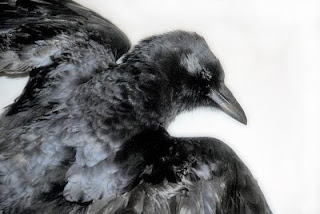 The dead crow is on my deck, on a snack table, in a box, in a black garbage bag, weighted down by a rusty metal vise. The whole package of crow and box and vise is partially covered by this morning’s snow.
The dead crow is on my deck, on a snack table, in a box, in a black garbage bag, weighted down by a rusty metal vise. The whole package of crow and box and vise is partially covered by this morning’s snow.
While my husband and daughter were walking the dogs in the park yesterday, a fellow dog walker was looking for the keys he lost in the snow. Marty and Serena helped him look, and Steve eventually found them, so they headed back out of the park together. Steve put his dog on the leash and cautioned them about the dead crow that lay up ahead. Moments later, Marty and Serena were carefully rolling it into a discarded box with a stick while the walker looked on, incredulous. “What, are you channeling your inner ten-year-old?” Steve asked.
“It’s for my wife,” Marty told him.
“Well, she’s either gonna be really pleased or really pissed off!”
After some bit of (probably) unsatisfactory explanation, my family came home. I was in the kitchen pondering dinner. “We brought you something,” Marty said, a gleam in his eye.
“You’re gonna love it,” Serena added.
As revealing as it is that a man would bring his wife a dead crow—her first and only crow, living or dead—it is equally telling that his wife could guess the surprise just by the expression on her husband’s face. I nearly cried with reverent delight.
 While Marty went back out to retrieve the frozen blackbird, I fetched some rubber gloves and my camera, set up a spot with the best light, and locked the dogs out of the kitchen.
While Marty went back out to retrieve the frozen blackbird, I fetched some rubber gloves and my camera, set up a spot with the best light, and locked the dogs out of the kitchen.
I put on one of the gloves to pick it up and was surprised by its lack of weight. Still, the crow required two hands because of its size and its broken neck. The head and neck bobbed and flopped like a slinky. His eyes had disintegrated into crust; his beak was grained like wood. But his feathers were good as new, with a glorious kiss of red, and I imagined him flying over my house at sunset on his way to the park, wings glowing auburn in the last light.
Shooting the dead crow’s portrait was difficult. His wiggly neck made an upright pose impossible, and the kitchen’s dull yellow light added an artificial sickness. Too long inside and a moment of hot lights would have thawed him, and I wasn’t ready for the decomp to begin, so I let Marty pose him on some white foam core while I shot quickly and returned him to the cold.
Marty’s plan was to bury him in the yard, let him decompose, and dig him up later for the skeleton to add to our collection of rodent, fox, and deer skulls, turtle shells, and random bones of random beasts. But a skeleton has to be rearticulated, or it’s just another pile. “You could always try taxidermy,” Marty said, and before he could say another word, I was hunting down the maker of my trophy.
 Having never priced taxidermy, I hadn’t a clue—three hundred bucks? A hundred? And what would be the most I’d pay, considering I have only outgo (and no income)? Naturally, taxidermists seem to set up shop in the wilderness—faraway Maryland counties with a hunting season—rather than in the middle of the city. But I found one willing to stuff my bird for a mere $120. It will take two months because this is the end of hunting season, and the shop is full of stuff to stuff.
Having never priced taxidermy, I hadn’t a clue—three hundred bucks? A hundred? And what would be the most I’d pay, considering I have only outgo (and no income)? Naturally, taxidermists seem to set up shop in the wilderness—faraway Maryland counties with a hunting season—rather than in the middle of the city. But I found one willing to stuff my bird for a mere $120. It will take two months because this is the end of hunting season, and the shop is full of stuff to stuff.
Last night, my sleep was fitful. The wind rattled the windows and whipped around some stuff in the yard, and all I could think about was the bird—whether it would be ripped apart in the wind, whether some animal would get it, whether it would be covered with snow. I promised myself that if the crow remained intact overnight, I would get thee to taxidermy, and it did.
But my husband is squawking at the price, so while he showered, I prepared a list of reasons he should tell me to go ahead and stuff it.
To be continued.
(Next: To Stuff or Not to Stuff: That is the Question)
– – – – – –
If you would like to help me pay for the taxidermy, I would be happy to exchange it for a 5×7 dead crow print of your choice, signed and numbered!
